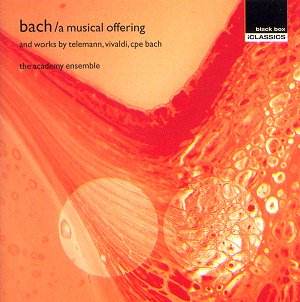|
|
Search MusicWeb Here |
|
 |
||
|
Founder:
Len Mullenger (1942-2025) Editor
in Chief:John Quinn
|
|
|
Search MusicWeb Here |
|
 |
||
|
Founder:
Len Mullenger (1942-2025) Editor
in Chief:John Quinn
|

|
Johann Sebastian BACH (1685-1750) Trio Sonata from A Musical Offering BWV1079 VIVALDI - Trio in A minor rv86 C.P.E. BACH - Trio Sonata in C major h571 (wq147) TELEMANN - Parisian Quartet no.3 in A major The Academy Ensemble Rec: ?, Cranleigh School Chapel (original release in 1992). |
| CD available for post-free online mail-order or you may download individual tracks. For some labels you can download the entire CD with a single click and make HUGE savings. The price you see is the price you pay! The full booklet notes are available on-line. |  |
|
NOTE • Click on the button and you can buy the disc or read the booklet details • You can also access each track which you may then sample or down load. • Further Information. |
|
|
The Musical Offering is the name of a set of pieces that Bach wrote for King Frederick II of Prussia. Bach's son, Carl Philip Emmanuel, was harpsichordist for the young king, who was an avid music lover. He begged the younger Bach to have his father come and play for him. One evening, Johann Sebastian showed up, and the King immediately ushered him to a pianoforte, where he played a theme for a fugue. "Old" Bach improvised a fugue to this theme, but was so impressed by it that he wrote a much larger set of pieces around this theme, and dedicated it to the King, hence, this Musical Offering.
Yet this recording is misleading in one light. If you do not read the track list, you could think that it contains the entire work, while it actually only contains the trio sonata which is at the heart of the work.
The Academy Ensemble perform this work well, without being exceptional. The violin sound of Richard Friedman is dense and almost old-fashioned, reminiscent of Yehudi Menuhin. The combination of such a violin and the other instruments strikes this listener as strange, yet it is not unpleasant.
The Vivaldi, which is for flute, bassoon, cello and harpsichord, suffers from this choice of instrumentation. The bassoon is an imposing instrument, and does not lend itself well to small ensembles. The harpsichord is all but drowned out, though the flute is prominent along with the bassoon.
The C.P.E. Bach sonata is much more balanced, and the musicians finally sound like a real ensemble here. They seem to be in total harmony with this music, and one can feel their enjoyment permeating it. This delightful work, written when the young Bach was only 17, though revised 16 years later, has some very interesting sections, and shows well the quality of this Bach sonís music.
The Parisian Quartet no. 3 by Telemann, again shows the problems of instrumentation. In this recording, a cello replaces the original viola da gamba, and the bassoon plays continuo. There is a harpsichord in there somewhere, though you need to stretch your ears to hear it.
This is a lacklustre recording, featuring some fine music
which suffers from uninspired playing and recording problems. If you want
to hear Bachís Musical Offering, get the Jordi Savall recording that was
released in 2001. |
A. VIVALDI
C.P.E. BACH
Get a free QuickTime download here |
|
ADDITIONAL INFORMATION •
You can sample only 30 seconds (or 15% if that is longer) of a given track. Select from the View tracks list. Each sample will normally start from the beginning but you can drag the slider to any position before pressing play. • PLEASE NOTE: If you are behind a firewall and the sound is prematurely terminated you may need to register Ludwig as a trusted source with your firewall software.
•You will need Quicktime to hear sound samples. Get a free Quicktime download here • If you cannot see the "Sample All Tracks" button you need to download Flash from here.
|
|
|
Return to Index |